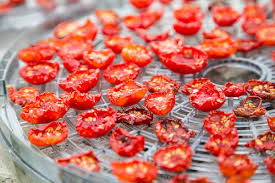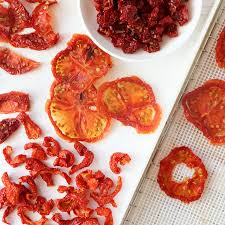Every year, as the summer tomatoes ripen, the hum of my food dehydrator fills the air. While canning and freezing are common methods, I always make room for drying. Dehydrated tomatoes offer one of the most space-efficient ways to preserve them, and the preparation is quick—simply slice fresh, clean tomatoes and let the dehydrator work its magic.
I use an electric dehydrator for tomatoes, but those in drier climates can use a solar dehydrator. Tomatoes are about 93% water, so even with an electric dehydrator, the process can take several hours. Without consistent airflow, tomato slices risk mold growth, making it important to control the drying process carefully.
A quick rant: There are countless online recipes that promise to create sun-dried tomatoes in an oven. While you can bake tomatoes slowly to make “half-dried” tomatoes, this is not true dehydration. A dehydrator, whether electric or solar, is essential for transforming tomatoes from their juicy state into leathery, concentrated pieces with rich color and flavor.
Best Types of Tomatoes for Drying
All tomato varieties can be dehydrated, but some work better than others. High-moisture tomatoes like cherry and large slicing varieties are perfect for drying, especially those that didn’t make it into a salad or sandwich. These tomatoes retain their flavor when dried and are great for use in sauces, pasta salads, or chili. However, because of their high water content, they may need to be processed with a food mill to remove seeds before using in a sauce.
On the other hand, paste tomatoes are drier and dehydrate faster. While I prefer to can them, mixing a variety of tomatoes into the dehydrator can lead to a diverse and flavorful batch.

Preparing Tomatoes for Drying
When preparing tomatoes for dehydration, you need a sharp serrated knife. For cherry tomatoes, cut them in half; for larger tomatoes, slice them into quarters. For thick slicing tomatoes, aim for slices around 8-9 mm (just under ½ inch). Thin slices can dry unevenly and may darken.
You don’t have to peel tomatoes before dehydrating, although you can by blanching them briefly in boiling water. I prefer to leave the skins on because they help maintain structure during drying, and when rehydrated, the skins naturally separate and can be removed easily if desired. Seed removal is optional, but I typically leave the seeds in to preserve the full flavor and nutrients.

Dehydrating Tomatoes in Stages
Dehydrators work by circulating warm air, but not always evenly. To ensure uniform drying, rotate the trays every few hours, especially during the first 3-4 hours when tomatoes go through a gooey phase. If you try to move them during this stage, they’ll tear apart. But once they shrink into leathery pieces or “tomato raisins,” they will easily peel off the trays. This process typically takes 8-10 hours.
Once dehydrated, tomatoes benefit from a conditioning period. Store them in a large jar for 24 hours at room temperature to allow moisture to evenly distribute. After this, they may feel slightly damp, requiring an additional hour in the dehydrator to ensure they are fully dry.

Storing Dried Tomatoes
After the conditioning process, store the tomatoes in airtight containers in a cool, dark place. They will last up to six months at room temperature, and can be kept for up to a year in the freezer. Dehydrating tomatoes is the most efficient way to preserve large amounts, allowing you to fit a surprising amount—like 15 pounds of fresh tomatoes—into a single quart jar, ready for any recipe.
